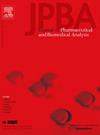Integrated metabolomics and network pharmacology to explore the clinical efficacy and mechanism of Yinchenhao decoction combined with nucleoside analogues on chronic hepatitis B
IF 3.1
3区 医学
Q2 CHEMISTRY, ANALYTICAL
Journal of pharmaceutical and biomedical analysis
Pub Date : 2024-10-19
DOI:10.1016/j.jpba.2024.116513
引用次数: 0
Abstract
Yinchenhao decoction (YCHD) is widely used in the treatment of damp-heat syndrome of chronic hepatitis B (CHB), but it remains unclear about the active compounds in YCHD and its potential mechanism for treating CHB. The purpose of this work is to evaluate the clinical efficacy of YCHD combined with nucleoside analogues (NAs) for the treatment of CHB. Besides, based on the exact clinical efficacy, we combined serum metabolomics and network pharmacology to screen differential metabolites and related pathways regulated by YCHD to investigate the possible mechanism for treating CHB. It revealed that NAs plus YCHD could significantly improve alanine aminotransferase (ALT) and aspartate aminotransferase (AST) levels, increase HBV-DNA negative rate (P<0.05), reduce the levels of inflammatory factors and LSM (both P<0.05), regulate lipids (P<0.05), and improve the symptoms of traditional Chinese medicine (TCM) (P<0.05) in CHB patients. YCHD was relatively safe. It showed 30 active compounds including chlorogenic acid, geniposide, emodin, quercetin, kaempferol, β-sitosterol and aloe emodin, and 115 key targets which were related to the regulation of lipids and reduction of oxidative stress related to the effect of YCHD in CHB in the network pharmacology analysis. We found 9 core targets and 4 key metabolites according to metabolomics, which were partly consistent with the network pharmacology findings. It proved that network pharmacology combined with metabolomics can well explain the “multi-component-multi-target” mechanism of complex TCM.
整合代谢组学和网络药理学,探讨银翘煎联合核苷类似物治疗慢性乙型肝炎的临床疗效和机制
银翘散(YCHD)被广泛用于治疗慢性乙型肝炎(CHB)的湿热证,但关于银翘散中的活性化合物及其治疗CHB的潜在机制仍不清楚。本研究的目的是评估一清片联合核苷类似物(NAs)治疗慢性乙型肝炎的临床疗效。此外,在临床疗效确切的基础上,我们结合血清代谢组学和网络药理学,筛选了YCHD调控的差异代谢物和相关通路,研究其治疗CHB的可能机制。结果显示,NAs加用一氢双氨可明显改善丙氨酸氨基转移酶(ALT)和天门冬氨酸氨基转移酶(AST)水平,提高HBV-DNA阴性率(P<0.05)。
本文章由计算机程序翻译,如有差异,请以英文原文为准。
求助全文
约1分钟内获得全文
求助全文
来源期刊
CiteScore
6.70
自引率
5.90%
发文量
588
审稿时长
37 days
期刊介绍:
This journal is an international medium directed towards the needs of academic, clinical, government and industrial analysis by publishing original research reports and critical reviews on pharmaceutical and biomedical analysis. It covers the interdisciplinary aspects of analysis in the pharmaceutical, biomedical and clinical sciences, including developments in analytical methodology, instrumentation, computation and interpretation. Submissions on novel applications focusing on drug purity and stability studies, pharmacokinetics, therapeutic monitoring, metabolic profiling; drug-related aspects of analytical biochemistry and forensic toxicology; quality assurance in the pharmaceutical industry are also welcome.
Studies from areas of well established and poorly selective methods, such as UV-VIS spectrophotometry (including derivative and multi-wavelength measurements), basic electroanalytical (potentiometric, polarographic and voltammetric) methods, fluorimetry, flow-injection analysis, etc. are accepted for publication in exceptional cases only, if a unique and substantial advantage over presently known systems is demonstrated. The same applies to the assay of simple drug formulations by any kind of methods and the determination of drugs in biological samples based merely on spiked samples. Drug purity/stability studies should contain information on the structure elucidation of the impurities/degradants.

 求助内容:
求助内容: 应助结果提醒方式:
应助结果提醒方式:


